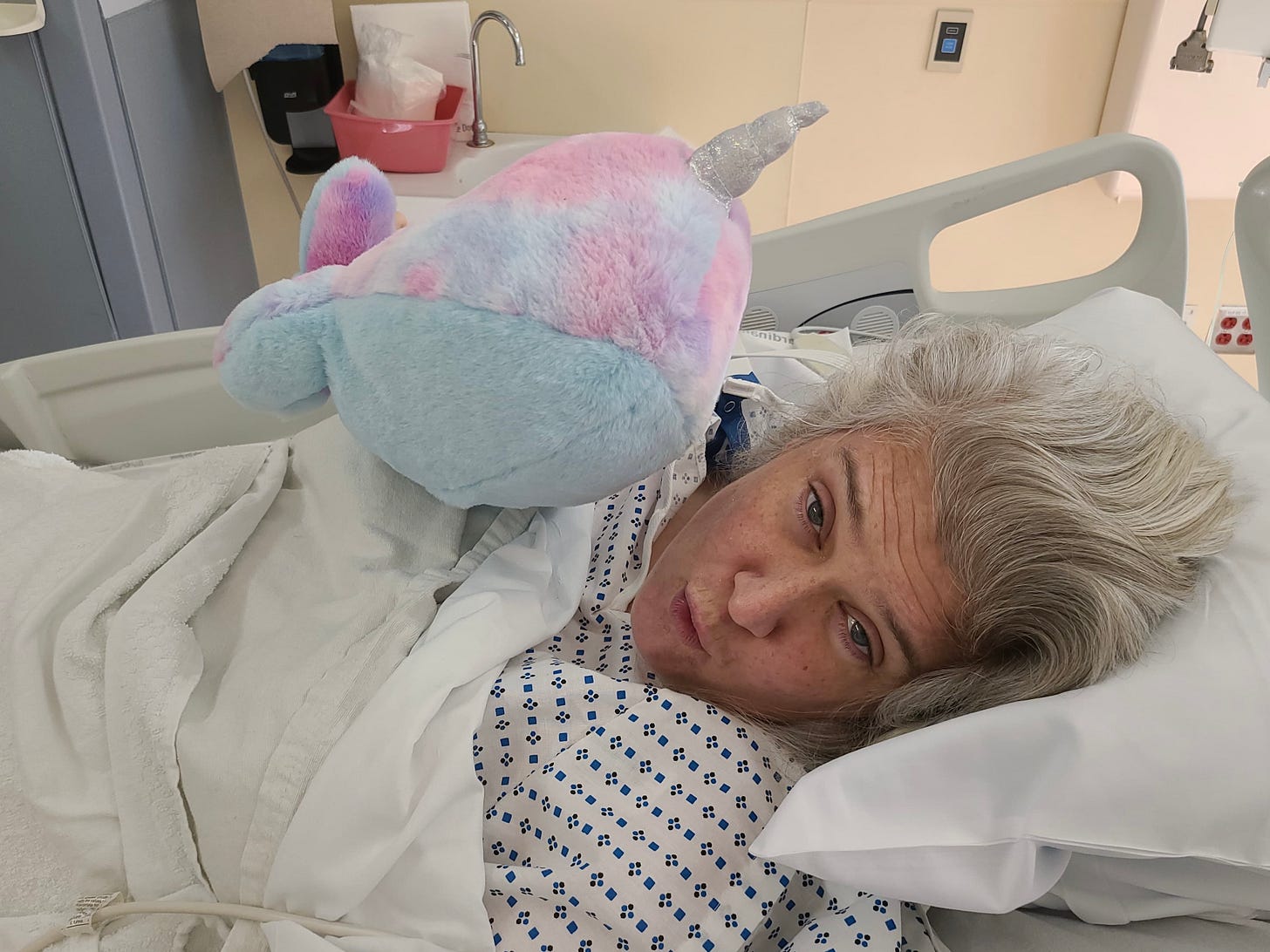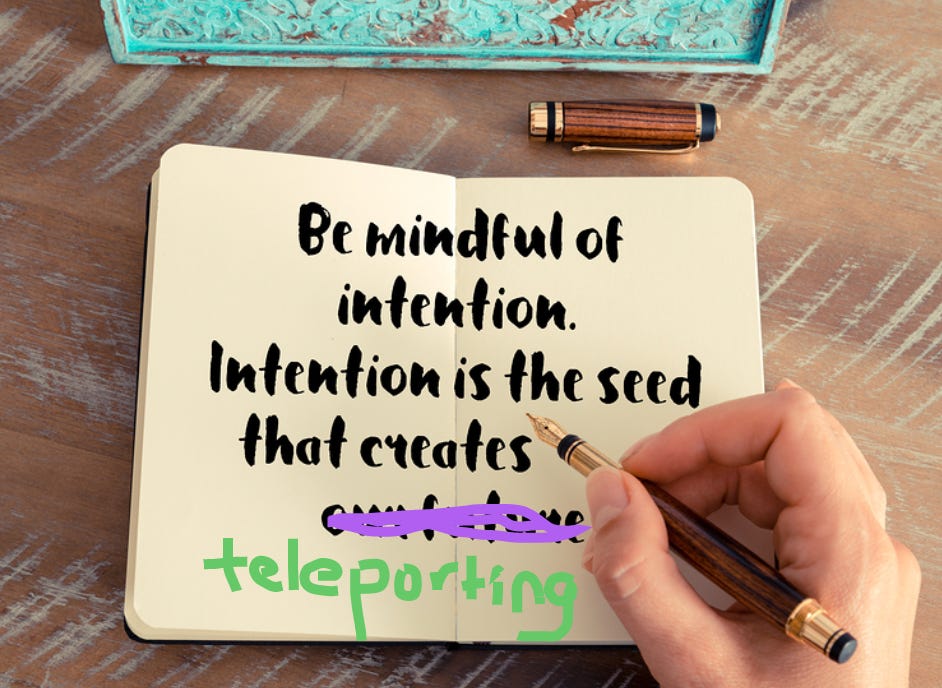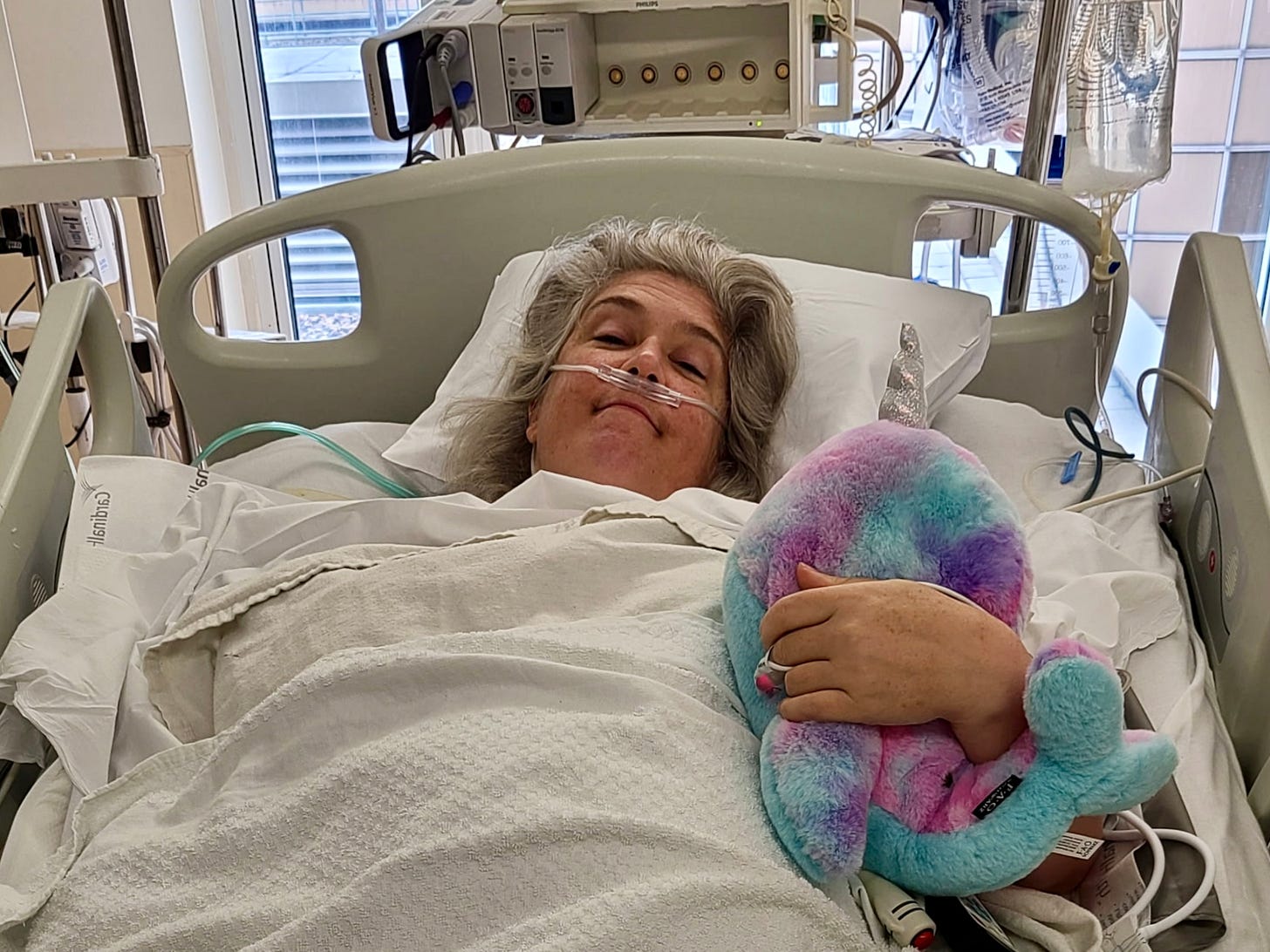Little Things
brain surgery and the week after
Two weeks ago tomorrow, I had neurosurgery - and what a weird sentence that is to write! In fancy words, this is what happened: a surgeon specializing in neurovascular procedures used interventional radiology first to rule out the presence of arteriovenous fistulas and then to guide a 9 x 80mm mesh stent into my right transverse sigmoid sinus, with the goal of alleviating cerebrospinal fluid buildup and the intracranial venous hypertension caused by giant arachnoid granulations and subsequent narrowing of the sigmoid space.
Or, in less fancy words: on July 17, I got me a Brain Drain.
For a leisurely two-year stretch, this surgery was only a vague possibility - the sort of thing that would only become necessary if an entire series of unlikely events took place. We knew that I had severe stenosis of the main veins that help drain CSF and regulate intracranial pressure, but I was optimistic after my August 2024 lumbar puncture and subsequent CSF leak that those veins had just been squished by the high pressure of the original bout of viral meningoencephalitis, and that the sudden lack of almost any intracranial pressure would allow them to re-open. (Side note: if all one’s doctors are going to freak the F out when you develop tonsillar herniation, they should really re-name it something scarier. It wasn’t until an anesthesiologist started talking to me an epidural blood patch that I groked how serious things were. Whoever named THAT procedure was firing on all cylinders.)
Indeed, after I recovered from the leak, I felt amazing for two whole months. Then my pressure gradually started to increase again, and in April the VZV bubbled up in my eye again. At that point my neuro-ophthalmologist encouraged/ commanded me to schedule a consult here about venous sinus stenting, but there was still no sense of rush.
Like a phone that displays ads for shop vacs as soon as you say “We should really clean out the car,” however, my brain must have been listening in. I started feeling truly horrible almost immediately after the surgical consult, and on July 8 an emergency visit to the neuro-ophthalmologist confirmed that my intracranial pressure had gone from “high” to “way too high” and was (again) endangering my eyesight (among other things). Rather than doing another lumbar puncture (the normal protocol for the level of pressure I had achieved), my neurologist prescribed me a blast of prednisone, put me back on Diamox, and talked my neurosurgeon into moving my surgery up to the following week. (I hadn’t actually lost my vision, so there was time to let the anti-coagulation meds do their magic. Not to brag, but although I’ve dealt with most of the effects WebMD lists for herpes zoster ophthamalicus, viral meningoencephalitis, and high intracranial pressure, I haven’t had to deal with total vision loss, facial paralysis, coma OR death! Andy and I have made a little chant out of this list, and I cling to it when things are going south. No. Facial. Paralysis. Yay!!)
In any event, there I suddenly was, scheduled for neurosurgery on July 17. I didn’t have a lot of nerves about the procedure ahead of time - partly because everything happened so fast, partly because my brain injury messes with my imaginative capacities such that I wasn’t able to picture anything past going into the hospital for the procedure, and partly because I was so spaced out from being back on Diamox and generally miserable from the high intracranial pressure that I was spending 90% of my time either sleeping or lying in bed listening to an audiobook, dissociating from pain, and would have happily accepted a wandering plague doctor’s offer of trepanning. All in all, I was pretty chipper in a super-low-energy way as we drove into NYC, checked into Milstein Hospital, and got settled in the ‘neurological interventional radiology’ unit on the 4th floor. (It is wild to me - in the best possible way - that medical advancements have gotten so specialized that this is its own unit.) They got me set up with an IV, drew blood, ran anti-coagulation tests to make sure my blood was nice and runny, and eventually took me back into the operating room.
The pre-op room where they took vitals and started IVs and such had been disappointingly Standard Hospital Clinic: I’d been surrounded by fellow patients also sitting at little chair-stations, and it was all very “So you think you have pneumonia” instead of “We’re prepping you for a space-age radiological procedure whose first clinical trials happened at this hospital less than 10 years ago”. In contrast, the actual operating room was reassuringly ice cold, full of medical techs and stainless steel machines, and included an Avenger-worthy array of complicated medical monitors both suspended from the ceiling and looming up from the floor. Andy and I had been joking that even if the surgery weren’t effective, it might at least leave me with an accidental superpower, so as two techs helped me onto the table, I took a moment to re-set my intention for ‘teleportation’.
Before they did anything else, the surgeon had the whole team introduce themselves - which I thought was brilliant, even if I did immediately forget them all. A guy holding a small electric razor then explained that he was going to need to ‘to prep my surgical site’, and I told him to “shave away!”. (I had cause to re-think the enthusiasm of this endorsement when I caught sight of my ‘area’ after surgery and realized I was now sporting what I will - with no further elaboration - call ‘the Upside-Down TinTin’.) Then the anesthesiologist (who had introduced herself and explained what she was going to do when we were still in the ‘on deck’ area) came over and told me she was going to administer some versed so they could get started. I got as far as, “Oh! My friend Lindsay said that feels like getting hit by three margarit…” and then the next thing I knew, I was waking up and it was all over.
The next few hours are a blur - what Andy tells me is that the surgeon came and told him and our friends who were waiting with him that everything had gone splendidly, and that they should be able to see me in half an hour. As it happened, it was closer to two hours: the recovery room was full, and so I stayed put in the procedure room until they had a room open for me in the Neuro ICU. By the time I got up there around 4:30/5pm, I was semi-aware and thrilled to snuggle the narwhal Anna and Jeff had brought me.
Anna and Jeff (claim that they) gave me a big hug, (apparently) laughed at how stoned I was, and then let Andy stay with me until around 8pm, at which point he headed off “to let me sleep” while he had dinner and stayed the night with a friend of ours who lived nearby.
The following night was not my favorite, and little if any sleep was involved. I was, of course, wired to machines on every side: I had an IV and pulse-ox monitor attached to one arm and an automatic blood-pressure cuff affixed to the other. I had EKG electrodes stuck to my chest with their wires running up past my head and a Foley catheter draining towards my feet - plus a monitor from the surgery still stuck on a toe that I couldn’t see or reach. And my oxygen levels kept dropping below 94% (apparently not uncommon post-intubation), so they kept sticking the oxygen cannula back under/in my nose and giving me liters of O2. I also had to spend the first few hours with my bed tilted with my head up and my feet down, so that I slid down slowly and helplessly until my feet touched the bottom rail. Finally, and not surprisingly, I had an incredibly sore throat from being intubated and a splitting headache from where the stent had been placed. All totally normal and to be expected post-surgery, but un-fun nevertheless.
In retrospect, I should have asked for better pain meds. They offered me Tylenol and told me I could have Tramadol if I wanted. What I should have said was “What’s Tramadol?” and then “Can I have some?”, whereas what I actually said was: “I guess Tylenol sounds ok.” (You know those studies that show how women get paid less than men in part because they’re more likely to accept whatever salary is first offered? Turns out I do that with pain management. If they’d led with an offer of Tramadol, I would have just taken that.) It was a weird phenomenon: I knew even in my post-surgical daze that everyone had encouraged me not to be a hero and to ask for anything I needed, but I honestly didn’t think I was being a hero. Sure, Tylenol didn’t make my headache go away completely, but it’s not like I was writhing in agony! I was just uncomfortable and unable to sleep and my head hurt. So they kept giving me 650mg of Tylenol every four hours, and I kept gritting my teeth while I waited for the night to be over.
[NOTE: I have resolved that if I ever have to do this or anything like it again, I will get Andy to write “Ignore what she says! Give her the good meds!” on my forehead in bright purple Sharpie. Or at least have that embroidered in rainbow sparkles on a pillow that he brings me in recovery.]
For better or worse, I was never left alone for long. The nurses assigned to my case came to check in on me frequently (and were seriously amazing; I got such good care from Cindi that night and Lauren the next day), with special attention to the incisions in my femoral artery (on the right side of my groin) and femoral vein (on the left). Multiple medical interns and residents came to see me over the course of the night to give me neurological exams - and also check on the incisions in my groin. At some point, a medical attending came to see me and give me a neurological exam - and also check on the incisions in my groin, as did a PA. My surgeon also came to see me and give me a neurological exam - and check the incisions in my groin. He assured me that the surgery had been a complete success, so I forgave him as he became approximately the tenth person in three hours to pull down my sheet and pull up my hospital gown to examine the neatly bandaged creases of my upper thighs.
Before he left for the night, the surgeon also told the nurse that my Foley catheter could come out, at which point my formerly-brilliant plan of drinking all the water to re-hydrate because I was catheterized anyway became a case of fools rushing in where angels fear to tread. I wasn’t allowed to get out of bed by myself and was offered either a bedpan or a bedside commode with the nurse’s assistance…while still hooked up to all the monitors. (None of the neuro ICU rooms had bathrooms, which seems fair. If you’re there, you’re almost certainly not in a state to get out of bed alone, much less pop over to the toilet or shower.) If you know anything about me, you know that I opted for the slight dignity the commode offered, but it did add another layer to the whole post-surgical experience.
One lovely thing about being on the neuro ICU ward, though, was that I had my own room. It wasn’t exactly private: the front wall was all glass with a sliding glass door and slidable curtains that were kept open, with my bed was facing directly into the hall so the nurses could keep an eye on me. Still, I could look out into three other rooms when I couldn’t sleep and play “Guess Their Condition” based on the extensive neurosurgical knowledge I’ve gleaned from decades of Grey’s Anatomy. And I didn’t have a roommate playing the TV at top volume while also talking to her family and friends at top volume, like I did the week I spent on the regular neuro ward in 2023. It was also a blessing when I had to use the commode, because then the nurse did close the curtains.
Eventually the night ended. Doctors started doing rounds, Andy came back and brought me coffee, and the giant bruise that had been creeping out from under the bandage on my left groin was declared “normal” and not worth keeping me in the hospital for another day to monitor. I was even allowed to walk all the way down the hall and around a corner to use a real bathroom! It was all very “For lo the winter is past and the rains have come and gone,” and my outlook on life improved immensely.
It helped that my surgeon also stopped by again and reiterated how well the procedure had gone. There were no AV fistulas, and the stenting had immediately reduced the pressure gradient in the right transverse sigmoid sinus to zero (which is what you want, since that means the vein is nice and open and blood is just flowing through, as opposed to squeezing through, which creates a pressure build-up). Dr. Lavine also told me I could expect to have a fierce headache for up to a week, on the grounds that “It’s a sizable catheter we have to jam up there to get the stent in.” I could swear he also described my arachnoid granulation as “a big ol’ sucker”, but I was admittedly still a little groggy from the anesthesia. I asked how soon the pressure in my head was likely to normalize; he said that it was a great sign that the whooshing in my ears had already stopped, but that it would ‘take some time’ for my vision to clear, etc. He didn’t give me an exact timeline, but suggested that six weeks was a good rule of thumb.
I cleared all the post-surgical hurdles and was discharged that day - Andy and I spent the next 24 hours being taken care of by a wonderful friend in NYC, so I wouldn’t have to endure a 2-hour car ride and so we’d be near the hospital just in case something went south. The next day, I lay in the backseat of our Kia Niro as we headed home and spent the next week on the same sort of restrictions you get post-C-section: no lifting, straining, pulling, etc. Stairs sparingly. Walking ‘in moderation’. Basically, nothing that would put pressure on the incisions in my femoral arteries or brand-new brain stent.
I had a hard time sleeping for the first week, but that’s worn off now and I find that I’m just waiting to see how much the stent helps. So far, it’s eliminated the high-pitched whooshing sound in my right ear (not so much my left), reduced my nausea by at least 90%, reduced my fatigue by 70%, and made a huge difference for the nerve pain in my spine, arms, and legs. Really, the only thing it hasn’t helped at all with (yet) is my vision! (That’s actually gotten worse since the surgery - which I tell myself is the result of my brain needing to re-regulate all sorts of things, and not a sign that my optic nerves have been permanently damaged.) So I’d say it’s been a definite success. The sensation of being able to do things like “meet someone for coffee” and “attend the cake and dagger book group” - and to want to do things like that - is a delight.
Whether it will have any effect on the recurring VZV meningitis is another question, and I’ve still got the brain injury fun-times. But for now, I’m feeling a bit better already and surrounded by loving friends and family. At the end of the day, I suppose that’s better than teleportation.
Until next time, be nice to your noggins!





These updates are just amazing on so many levels, Christina! The medical details are fascinating (and often terrifying!) but your story-telling is just next-level. I am in awe of your ability (and willingness) not only to relate such a challenging personal experience in such riveting detail but to do so in a voice that, while realistic, is nonetheless full of optimism and good humor (indeed, often enough, outright hilarity). You are often in my thoughts and I am truly hoping and praying for your return to full health.
Brain drain, brain gain --I hope!